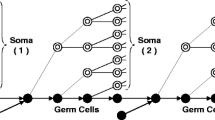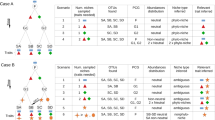Abstract
The recent conception of biodiversity proposed by James Maclaurin and Sterelny was developed mostly with macrobiological life in mind. They suggest that we measure biodiversity by dividing life into natural units (typically species) and quantifying the differences among units using phenetic rather than phylogenetic measures of distance. They identify problems in implementing quantitative phylogenetic notions of difference for non-prokaryotic species. I suggest that if we focus on microbiological life forms that engage in frequent, promiscuous lateral gene transfer (LGT), and their associated reticulated phylogenies, we need to rethink the notion of species as the natural unit, and we discover additional problems with phylogenetic notions of distance. These problems suggest that a phenetic approach based on morphospaces has just as much appeal, if not more, for microbes as they do for multi-cellular life. Facts about LGT, however, offer no new insight into the additional challenge of reconciling units and differences into a single measure of biodiversity.






Similar content being viewed by others
Notes
This distinction between α-differences and β-differences is distinct from the distinction made by Whittaker (1972) between α-diversity, which is an absolute notion that applies to a given place, and β-diversity, which is relational and measures how adding the place in question to another increases biodiversity.
They then modify these weightings using information theoretic reasoning, but for the sake of clarity of the argument, I omit these details.
References
Achenbach LA, Coates JD (2000) Disparity between bacterial phylogeny and physiology. ASM News 66:714–715
Achtman M, Wagner M (2008) Microbial diversity and the genetic nature of microbial species. Nat Rev Microbiol 6:431–440
Allison M (2006) Star clusters and how to observe them. Springer-Verlag, London
Altschul SF, Gish W, Miller W, Myers EW, Lipman DJ (1990) Basic local alignment search tool. J Mol Biol 215:403–410
Bapteste E, Boucher Y (2008) Lateral gene transfer challenges principles of microbial systematics. Trends Microbiol 16:200–207
Benson DA, Karsch-Mizrachi I, Lipman DJ, Ostell J, Wheeler DL (2008) GenBank. Nucleic Acids Res 36:D25–D30. doi:10.1093/nar/gkm929PMID18073190
Berman HM (2008) The protein data bank: a historical perspective. Acta Crystallogr A A64(1):88–95. doi:10.1107/s0108767307035623
Brun Y, Shimkets LJ (2000) Prokaryotic development. ASM Press, Washington, DC
Caspar DLD (1964) Structure and function of regular virus particles. In: Corbett MK, Sisler AD (eds) Plant virology. University of Florida Press, Gainesville, pp 267–291
Caspar DLD, Klug A (1962) Physical principles in the construction of regular viruses. Cold Spring Harb Sym XXVII:1–24
Cohan FM (1994) Genetic exchange and evolutionary divergence in prokaryotes. Trends Ecol Evol 9:175–180
Cohan FM (2001) Bacterial species and speciation. Syst Biol 50:513–524
Cohan FM (2002) What are bacterial species? Annu Rev of Microbiol 56:457–487
Colwell RR (1997) Microbial diversity: the importance of exploration and conservation. J Ind Microbiol Biot 18:302–307
Doolittle FW (1999) Phylogenetic classification and the universal tree. Science 284:2124–2128
Doolittle FW, Papke RT (2006) Genomics and the bacterial species problem. Genome Biol 7:116
Dupré J, O’Malley MA (2007) Metagenomics and biological ontology. Stud Hist Philos Sci C 38:834–846
Dykhuizen DE, Green L (1991) Recombination in Escherichia coli and the definition of biological species. J Bacteriol 173:7257–7268
Eisen JA (2007) Environmental shotgun sequencing: it’s potential and challenges for studying the hidden world of microbes. PLoS Biol 5(3):e82. doi:10.1371/journal.pbio.0050082
Ereshefsky M (2010) Microbiology and the species problem. Biol Philos (this issue). doi:10.1007/s10539-010-9211-9
Faith D (1992) Conservation evaluation and phylogenetic diversity. Biol Conserv 61:1–10
Faith D (1994) Phylogenetic pattern and the quantification of organismal biodiversity. Philos T R Soc B 345:45–58
Feil EJ, Maiden MC, Achtman M, Spratt BG (1999) The relative contributions of recombination and mutation to the divergence of clones of Neisseria meningitides. Mol Biol Evol 16:1496–1502
Feil EJ, Holmes EC, Bessen DE, Chan M, Day NPJ, Enright MC, Goldstein R, Hood DW, Kalia A, Moore CE, Zhou J, Spratt BG (2001) Recombination within natural populations of pathogenic bacteria: Short-term empirical estimates and long-term phylogenetic consequences. Proc Natl Acad Sci USA 98:182–187
Franklin LR (2007) Bacteria, sex and systematics. Philos Sci 74:69–95
Gogarten JP, Doolittle WF, Lawrence JG (2002) Prokaryotic evolution in light of gene transfer. Mol Biol Evol 19:2226–2238
Hendrix RW (2005) Bacteriophage HK97: assembly of the capsid and evolutionary connections. Adv Virus Res 64:1–14
Hendrix RW, Smith MCM, Burns RN, Ford ME, Hatfull GF (1999) Evolutionary relationships among diverse bacteriophages and prophages: all the world’s a phage. Proc Natl Acad Sci USA 96:2192–2197
Howe MA (1987) Phage Mu: An overview. In: Symonds N, Toussaint A, van de Putte P, Howe MM (eds) Phage Mu. Cold Spring Harbor Laboratory Press, Cold Spring Harbor NY, pp 25–39
Hughes JB, Hellmann JJ, Ricketts TH, Bohannan BJM (2001) Counting the uncountable: statistical approaches to estimating microbial diversity. Appl Environ Microb 67:4399–4406
Huson DH, Bryant D (2006) Application of phylogenetic networks in evolutionary studies. Mol Biol Evol 23:254–267
Koonin EV, Kira S, Makarova KS, Aravind L (2001) Horizontal gene transfer in prokaryotes: quantification and classification. Annu Rev Microbiol 55:709–742
Kurland CG, Canback B, Berg OG (2003) Horizontal gene transfer: a critical view. Proc Natl Acad Sci USA 100:9658–9662
Lawrence JG, Retchless A (2010) The myth of bacterial species and speciation. Biol Philos (this issue). doi:10.1007/s10539-010-9215-5
Lawrence JG, Hatfull GF, Hendrix RW (2002) Imbroglios of viral taxonomy: genetic exchange and failings of phenetic approaches. J Bacteriol 184(17):4891–4905
Liu WT, Marsh TL, Cheng H, Forney LJ (1997) Characterization of microbial diversity by determining terminal restriction fragment length polymorphisms of genes encoding 16S rRNA. Appl Environ Microbiol 63:4516–4522
Maclaurin J, Sterelny K (2008) What is biodiversity? University of Chicago Press, Chicago
Morgan GJ (2003) Historical review: viruses, crystals and geodesic domes. Trends Biochem Sci 28:86–91
Morgan GJ (2004) Early theories of virus structure. In: Cheng H, Hammar L (eds) Conformational proteomics of macromolecular architectures. World Scientific, Singapore, pp 3–40
Morgan GJ (2006) Virus design, 1955–1962: science meets art. Phytopathology 96:1287–1291
Morgan GJ (2007) Prioritizing the transformative value of biodiversity. Biol Philos 22:627–632
Morgan GJ (2009) The many dimensions of biodiversity. Stud Hist Philos Sci C 40:235–238
Morgan GJ, Pitts WB (2008) Evolution without species: the case of mosaic bacteriophages. Brit J Philos Sci 59:745–765
Morgan GJ, Hatfull GF, Casjens S, Hendrix RW (2002) Bacteriophage Mu genome sequence: analysis and comparison with mu-like prophages in Haemophilus, Neisseria and Deinococcus. J Mol Biol 317:337–359
O’Malley MA (2010) Ernst Mayr, the tree of life, and philosophy of biology. Biol Philos (this issue). doi:10.1007/s10539-010-9214-6
O’Malley MA, Dupré J (2007) Size doesn’t matter: towards a more inclusive philosophy of biology. Biol Philos 22:155–191
Ochman H, Lerat E, Daubin V (2005) Examining bacterial species under the specter of gene transfer and exchange. Proc Natl Acad Sci USA 102:6595–6599
Pace NR (1997) A molecular view of microbial diversity and the biosphere. Science 276:734–740
Raup D (1966) Geometric analysis of shell coiling: general problems. J Paleontol 40:1178–1190
Rusch DB, Halpern AL, Sutton G, Heidelberg KB, Williamson S (2007) The Sorcerer II global ocean sampling expedition: Northwest Atlantic through eastern tropical Pacific. PLoS Biol 5(3):e77. doi:10.1371/journal.pbio.0050077
Sarkar S (2005) Biodiversity and environmental philosophy. Cambridge University Press, Cambridge
Sogin ML, Morrison HG, Huber JA, Welch DM, Huse SM, Neal PR, Arrieta JM, Gerhard J, Herndl GJ (2006) Microbial diversity in the deep sea and the underexplored “rare biosphere”. Proc Natl Acad Sci USA 103:12115–12120
Stackebrandt E, Goebel BM (1994) Taxonomic note: a place for DNA-DNA reassociation and16S rRNA sequence analysis in the present species definition in bacteriology. Int J Syst Bacteriol 44:846–849
Vane-Wright RI, Humphries CJ, Williams PH (1991) What to protect—systematics and the agony of choice. Biol Conserv 55:235–254
von Wintzingerode F, Göbel UB, Stackebrand T (1997) Determination of microbial diversity in environmental samples: pitfalls of PCR-based rRNA analysis. FEMS Microbiol Rev 21:213–229
Wagner P (1995) Diversity patterns amongst early gastropods: Contrasting taxonomic and phylogenetic descriptions. Paleobiology 21:410–439
Wayne LG, Brenner DJ, Colwell RR, Grimont PAD, Kandler O, Krichevsky MI, Moore LH, Moore WEC, Murray RGE et al (1987) Report of the ad hoc committee on reconciliation of approaches to bacterial systematics. Int J Syst Bacteriol 37:463–464
Whittaker RH (1972) Evolution and measurement of species diversity. Taxon 21:213–251
Acknowledgments
I thank the audience at the Halifax meeting of Perspectives on the Tree of Life, sponsored by the Leverhulme Trust, for feedback and advice. Suggestions from David Silverstein, Donavan Parks, Rob Beiko, Ford Doolittle, Jeffrey Lawrence, Maureen O’Malley and two anonymous reviewers significantly improved the paper. I also thank Jeffrey Lawrence for the unpublished distance data that allowed the network in Fig. 5 to be calculated and Na-Young Kim for creating Figs. 3, 4 and 6.
Author information
Authors and Affiliations
Corresponding author
Rights and permissions
About this article
Cite this article
Morgan, G.J. Evaluating Maclaurin and Sterelny’s conception of biodiversity in cases of frequent, promiscuous lateral gene transfer. Biol Philos 25, 603–621 (2010). https://doi.org/10.1007/s10539-010-9221-7
Published:
Issue Date:
DOI: https://doi.org/10.1007/s10539-010-9221-7




